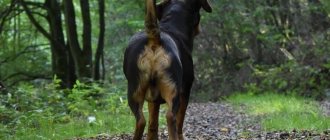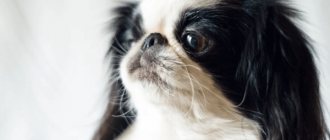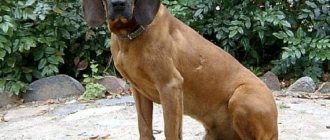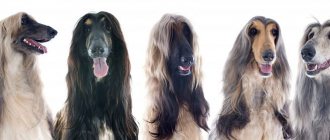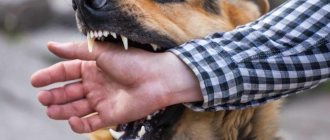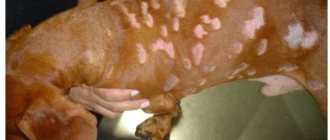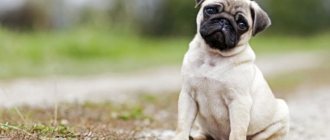Causes and forms of acanthosis nigricans in dogs
Dermatological disease has several subtypes:
- primary or genetic acanthosis, which develops almost from the moment the puppy is born or in the first year of its life;
- secondary or acquired acanthosis, which is provoked by various violations of the integrity of the epidermis and a number of other reasons;
- pseudoacanthosis, similar in its development to a true disorder, but characterized by severe inflammation of the skin.
Hereditary predisposition exists only in dachshund dogs. In this case, the disorder equally affects female and male animals. With this form of the disease, the first symptoms appear within a few weeks from birth.
Dachshunds are the most susceptible breed to acanthosis.
Acquired or secondary form of acanthosis occurs in any breed, but is most often diagnosed in smooth-haired dogs. With this course of the disease, pigmentation becomes a consequence of a previously occurring disease.
Such reasons include:
- oncological neoplasms of benign and malignant types;
- diseases of the endocrine system and kidneys;
- insufficient functioning of the genitourinary system, as well as infectious lesions;
- hormonal disorders, more common in females;
- constant stress or psycho-emotional shock, including after moving and loud noises;
- increased body weight and unhealthy diet;
- diseases of the digestive tract, chronic processes are especially dangerous;
- the presence of other diseases of the epidermis.
Pseudoacanthosis, unlike secondary, can also occur in a chronic stage. Rashes with a false form of the disorder are similar to normal ones, but are associated with the presence of an immune disease. Most often, this type of skin inflammation occurs due to allergies of any type, food allergies are especially dangerous, dermatitis, and insufficient hormone levels.
Attention! Pvsedoacanthosis can provoke an insufficiently active lifestyle of the dog. The owner is obliged to take care of the daily stress for his pet, trying to limit his mobility as little as possible, including in home and apartment conditions.
Advanced stage of acanthosis in a pug
Forms of the disease
Depending on the degree of damage, experts distinguish the following forms of the disease.
- Primary acanthosis . The disease is more common in dachshunds and affects animals of both sexes, starting from an early age. In most cases, this is due to genetic predisposition, chronic kidney disease or pathologies of the endocrine system. In the primary form of the disease, black spots on the dog’s body are located randomly. The increase in their size occurs gradually and is not accompanied by inflammation.
- Secondary acanthosis . Smooth-haired dogs are susceptible to the disease. It develops as a result of allergic reactions; for some pathologies of internal organs. It is also possible to develop acanthosis due to cancer, accompanied by malignant and benign neoplasms; in case of metabolic disorders; in stressful situations; in case of disruption of the thyroid gland, as well as in case of disturbance or change in diet. Black spots with secondary acanthosis nigricans are localized in the axillary or groin area. The appearance of dark spots is accompanied by the formation of a focus of inflammation. Usually its formation is associated with allergic dermatitis, in which the dog experiences severe itching.
- Pseudoacanthosis . This is a chronic skin inflammation in which the external symptoms are similar to secondary acanthosis. The disease can be caused by allergic reactions, a sedentary lifestyle, excess weight, dermatitis or hormonal imbalance.
Skin infections
Skin infections may occur on their own or may be secondary to an allergy. Regardless of the cause, if there has been an infection, it can lead to hyperpigmentation. Bacterial infections are the most common causes of skin infections.
- Mange (demodex, sarcoptic mange) can cause darkening. Demodex lesions are usually local.
- Sarcoptus usually becomes generalized. The discoloration may go away after scabies is treated, but it will remain after severe cases.
- Ringworm (dermatophytosis) can also cause temporary or permanent hyperpigmentation.
Veterinarians will ask the following questions:
- Why is the belly red or black?
- Where did the itching come from? How bad does it itch?
- Is there a foreign smell?
- Does it only itch at certain times of the year? (Allergy?)
The study is carried out by analyzing the medical history and diagnostics, for example, scraping, cytology, biopsy. If you adopt a dog that is healthy, not itchy anywhere, but has obvious dark areas, he probably suffered from illnesses such as allergies when he was little.
Symptoms of the disease with photographs
Regardless of the form of the disorder, acontosis has similar signs of its manifestation and localization. At the initial stage of formation, pathology is most often diagnosed in the armpit area. But black spots can also be found in the groin area, between the buttocks, and near the umbilical cavity. Less commonly, spots of accumulated melanin are found in the area of the elbow and knee joints, on the ears and neck.
Possible localization options for acanthosis
Once the disease starts, you may notice a number of symptoms characteristic of acanthosis nigricans.
- In the affected area, the skin becomes darker than usual.
- Gradually one feels its coarsening and thickening.
- Over time, the pigmentation of the epidermis becomes more pronounced, the spots approach black in color.
- In the acquired form of the disorder, the area from which the inflammation started is clearly visible.
- Gradually, the skin thickens more and more, pronounced folds appear in sore spots.
- In many dogs, benign growths form on the affected area, increasing in size without the necessary treatment.
- Many pets face the problem of hair loss in areas affected by acontosis; alopecia gradually spreads to healthy areas.
- Due to the resulting inflammation, the animal reacts sharply to touch, may become aggressive and lose appetite.
- Often the disorder is accompanied by itching; the dog tries to scratch the sore area in an effort to eliminate the discomfort.
Video - Dermatological problems of dachshunds
Attention! Skin itching and anxiety due to it are characteristic only of acquired acanthosis. If a genetic form of the pathology is registered in a dog, the animal experiences virtually no discomfort even in advanced stages.
Examination by a veterinarian for diagnosis
Diagnosis of the disease
Making an accurate diagnosis is not particularly difficult, since the symptoms of “elephant skin” are difficult to confuse with another dermatological problem. A veterinary diagnostic examination is necessary in order to identify the true cause provoking the development of pathology. This is especially true for the secondary type of acanthosis nigricans.
For diagnostic purposes, the following studies are carried out:
- laboratory blood test - to determine the presence of concomitant infection in the body;
- scrapings of damaged skin - to determine possible pathogenic bacterial or fungal microorganisms;
- smears from damaged areas - allow you to determine the type of inflammation on the skin;
- ultrasound examination of the thyroid gland - in case of suspected development of secondary acanthosis in older animals;
- biopsy of the affected areas of the skin is necessary in difficult cases when the above methods did not give positive results and the animal has complex dermatological diseases.
There is no complete cure for true acanthosis (primary type). A veterinary specialist can prescribe symptomatic therapy that minimizes unpleasant signs of the disease.
For therapy purposes, certain complexes of hormonal substances and ointments are used for external use.
General symptoms
Regardless of the type of disease, the clinical picture will be approximately the same. Initially, there is a barely noticeable darkening of the skin in the intergluteal region, on the abdomen, ears and inside the folds (head, limbs). Over time, the affected areas become more visible, standing out as black against the background of light skin.
Next, the skin changes density, becoming rough and hard to the touch. Growths of heterogeneous shapes appear in the folds. Sometimes this deformation is accompanied by a characteristic putrefactive odor. In parallel, alopecia may develop - gradual or, conversely, rapid hair loss in problem areas. The dog becomes restless, itches endlessly, does not allow darkened areas to be touched, and whines from pain and itching.
Diagnosis of acanthosis nigricans in dogs
If a disorder occurs, the doctor can make a diagnosis after an in-person examination. But to determine the exact condition of the animal and its complexity, a full examination is carried out. This is necessary, first of all, to identify the cause of the appearance of black spots on the dog’s skin.
Additionally, the specialist prescribes scrapings from the epidermis. They are required to exclude or confirm the presence of demodicosis and other dermatological pathologies. If acanthosis is suspected to be accompanied by infectious lesions, cultures are performed using a special medium. Such procedures also help to prescribe the correct antibacterial drug when the pathogen is confirmed.
In older individuals, it is mandatory to check the thyroid gland and the functioning of the adrenal glands. All dogs undergo allergy testing.
Attention! Such a complex procedure as a biopsy is prescribed extremely rarely. This is done only in the secondary course of the disorder to confirm or refute the presence of seborrhea, tick-borne infections and old skin lesions by bacteria.
Obesity is one of the causes of the development of the disorder in dogs
Treatment of acanthosis nigricans in a pet at home
What to do if an animal has dark spots? Only a veterinarian can make a diagnosis. To do this, the doctor sends tissue from the problem area for a biopsy. Diagnosis consists of excluding diseases with similar symptoms - food allergies, atopic dermatitis, endocrine disorders.
If the skin and nails darken due to a hereditary predisposition, then it will not be possible to achieve a complete recovery. For primary acanthoderma, maintenance therapy is prescribed: glucocorticoids, antihistamines. The black spots are very itchy, so the dachshund is washed with special shampoos and given sedatives.
For secondary acanthoderma, complex treatment is prescribed, which can take place at home. It involves the use of tools such as:
- Systemic glucocorticoids. The course of treatment lasts 7 days. The drug is given orally or by injection.
- Vitamins. The course of therapy continues for 3 months. Preferably vitamin E is prescribed, but other vitamin complexes may also be prescribed.
- Antibacterial shampoos. Since the dark spots constantly itch and sores form on them, an infection can get inside. It is recommended to wash your dog with antimicrobial shampoos more often.
We suggest you familiarize yourself with How to wipe a kitten’s eyes
What to do if your skin and nails are darkened due to a staph infection? In such a situation, the veterinarian prescribes immunostimulants and antibiotics: Baytril, Tsiflox, Enroxil. In advanced cases, the staphylococcal vaccine “Antifagin” is used, which is administered subcutaneously.
For obesity, which has contributed to the blackening of the dog's skin, a low-calorie diet is prescribed. The animal is prescribed physical activity, a set of exercises that will help reduce weight.
Acanthosis nigricans should not be left untreated. If the dog is not taken to the veterinarian in time, the disease will progress. Dark spots are itchy, so the animal will scratch them until they bleed. Bleeding, non-healing ulcers form on the abdomen, neck, and groin, which can very easily become infected.
Medications
Occasionally, dark spots appear on a dog’s belly after taking a course of iron supplements. This is due to iron deposition. This phenomenon does not pose any danger and can go away on its own just as it arose. Treatment of such spots is required only if they bother the pet.
Dark spots on a dog’s skin are extremely rarely an indicator of normality, and therefore require careful attention.
Skin diseases in dogs are becoming more common today. The reason lies in many aspects: improper and inadequate nutrition, deterioration of the ecological atmosphere of the air, a sedentary lifestyle, crossing with infected individuals. Often skin diseases in animals manifest themselves as hereditary predispositions to skin diseases.
Therapy for acanthosis nigricans at the initial stage
The treatment regimen at the initial stage of the disease includes several medications. Their effect is aimed at normalizing the psycho-emotional background, restoring the skin, stopping pigmentation of the epidermis and eliminating other unpleasant symptoms.
Etiderm
A medicinal shampoo that has an antimicrobial and restorative effect. Chitosanide, the active substance included in the drug, creates a protective barrier on the upper layer of the dog’s epidermis and fur. The dosage of shampoo should be prescribed by a doctor. For dogs weighing 10-20 kg, a single dose of 30 ml is sufficient. The animal's fur is moistened with warm water and Etiderm is applied with rubbing movements and washed off. Repeat the procedure. The second time, the active substance is left for 10 minutes and washed off. Treatment is carried out no more than 3 times a week with a mandatory break of at least one day. The course of therapy is individual.
Etiderm - medicinal shampoo
Doctor
A medicated tar-based shampoo that allows you to heal many dermatological pathologies in dogs. The medication contains birch tar, which eliminates inflammation and restores the skin. For therapy, you first need to wet the pet's fur and apply a small amount of shampoo, gently lather. The amount of medication is selected intuitively, taking into account the size of the individual.
After distributing the Doctor, you should wait about 5-10 minutes and rinse the hair well so that no active substance remains on it. Medicinal shampoo is used according to individual regimens, which include either daily use or application every 1-3 days. To eliminate the problem, 7-10 procedures are prescribed.
Shampoo Doctor against dermatological diseases in animals
Valerian officinalis
An herbal medicine that has a good calming effect. Can be used as a preventative treatment if the dog is constantly characterized by increased nervousness. For treatment, it is necessary to select the dose based on the pet’s weight. It is recommended to give a large breed over 20 kg 3 tablets of valerian at a time, with a weight of 10-20 kg - no more than two doses, small dogs are given one tablet. The number of daily doses varies depending on the severity of neurosis and acanthosis and can be 1-3 times.
Valerian officinalis
Diphenhydramine
An antihistamine, better known as Diphenhydramine. It has an antipruritic and anti-edematous effect, protecting the animal from excessive scratching and secondary infection. In dogs it is used in the form of subcutaneous or intramuscular injections. For treatment, only a concentrate in a dose of 1% of the active substance is used. The dose of Diphenhydramine is 0.6-0.8 mg/kg in the morning and evening, the course of therapy is according to indications. Additionally, it has an anti-inflammatory and calming effect.
Subcutaneous administration of a drug
Pipolfen and Allergan
Dispensed in the form of injections or tablets, the specific form for the pet is selected by the doctor. Injections are used for more advanced cases of acanthosis nigricans, accompanied by severe itching, inflammation and swelling. For intramuscular administration, a solution with a concentration of 2.5% diprazine, the main active ingredient, is used. The dosage of tablets and injections is 4.5-5 mg/kg two to three times a day for an individually determined time.
Pipolfen
Celandine Shampoo
It is an antiparasitic drug that strengthens the protective barrier of the skin, accelerates its healing, relieves itching and does not eliminate the consequences of flea and tick bites. For acanthosis nigricans at the initial stage of development, a single treatment of the pet is sufficient. To do this, you should wet it well and rub in a small amount of shampoo, be sure to pay special attention to the affected areas. After 10 minutes, wash off the celandine for dogs generously with warm water.
Celandine Shampoo
Prednisolone
Quite rarely used in the initial stages of acanthosis nigricans. At this stage it is usually prescribed to dachshunds due to their natural predisposition to pathology. The doctor selects the dose, since corticosteroid drugs are dangerous and can provoke unwanted reactions from all internal organs. The classic dosage of Prednisolone for acanthosis nigricans is 1 tablet daily for 5-10 days.
Prednisolone
Attention! All the described drugs and their analogues, if necessary, are also included in therapy to eliminate the advanced stage of acanthosis nigricans. But in this case, all medications should be spaced out correctly, as there may be bad drug interactions between them.
Intramuscular administration of the drug to a dog
Features of treatment of severe acanthosis in dogs
If the pathology cannot be stopped at the initial stage and the spots continue to grow, more serious medications are used. They often include injections.
Multivitamin
An injection preparation based on a vitamin complex, which includes vitamin E. It is necessary for the restoration and healing of the skin, and the removal of the inflammatory process. The dosage is selected based on the pet’s weight and age. For puppies, it is enough to administer 0.3 ml of solution, for individuals up to 15 kg - 0.3-1 ml, over 15 kg - 1-3 ml. The drug is injected subcutaneously or intramuscularly weekly or once every 14 days. The course of treatment can take up to three months, taking into account the severity of the disorder.
Multivitamin
Baytril
A medicine that belongs to the class of antibacterials. Prescribed when acanthosis is provoked by staphylococcal infections. Baytril can only be used after 12 months of life. The antibiotic dosage is 0.2 ml/kg. Injections are given subcutaneously once a day. The recommended duration of treatment is from three to seven days. If necessary, the course is extended, but only with positive dynamics.
Effective antibacterial drug Baytril against acanthosis nigricans
Sulfur shampoo
It is one of the most powerful remedies that prevent not only acanthosis nigricans, but also other dermatological disorders. When using it, you should protect your dog's eyes and mouth well, as the drug can burn the mucous membranes and cause severe damage to internal organs after entering the bloodstream. After carefully wetting the fur, a small amount of Sulfur Shampoo is distributed throughout the body, lightly rubbing it into the skin. After 10-20 minutes it is washed off well. Treatment procedures are repeated once every one to two weeks. In case of a congenital type of disorder, such treatment is carried out until the end of life, in case of a secondary type - according to the doctor’s indications.
Sulfur shampoo
Miconazole
The drug belongs to the group of antifungals and is used if acanthosis has developed as a result of a fungal infection or at the same time as it. For dogs, it is recommended to use the drug in the form of shampoo 1-2 times a week. When swimming, it is necessary to protect the eyes, ears and mouth of the individual well. After rubbing in the active component, you should wait 3-10 minutes, taking into account the severity of the disorder, then rinse off Miconazole well. Simultaneously with the fungus, the drug relieves itching, reduces inflammation and normalizes the sebaceous balance of the skin.
Miconazole
Melatonin
A serious drug whose action is aimed at restoring fur and stopping alopecia. The dosage of Melatonin should be adjusted by a doctor. Small breeds are not recommended to take more than 1 mg three times a day. Large dogs may receive more of the active ingredient based on the health of their kidneys and liver. The duration of treatment is seven days, increasing the course of therapy is possible only with the permission of the veterinarian.
Alopecia is one of the symptoms of pathology in dogs with acanthosis
You can read more about the problems that arise with alopecia in dogs here.
Ketotifen
It is used in the form of tablets when the disease remains uncontrollable for a long time. It can cause drowsiness and lethargy, sometimes the appetite drops significantly, and the dog begins to lose weight. When using Ketotifen in puppies, consult a veterinarian. The dose of the active substance is 0.02-0.05 mg/kg no more than twice a day. Therapy can be extended up to three months.
Sinaflan
Hormonal ointment, which is recommended to be prescribed only for severe disorders and large spots of acanthosis nigricans. The medicine should be applied strictly to the affected areas, avoiding healthy skin. The corticosteroid is prescribed in individual doses. It is usually applied once a day for 5-7 days or every other day for two weeks. It is worth considering that Sinaflan provokes withdrawal syndrome. Rarely used in puppies.
Sinaflan - hormonal ointment
Dexamethasone
Also a hormonal drug, prescribed in the form of injections. Dosages are selected taking into account the weight and condition of the dog’s skin. Usually inject 1-2 ml daily for no more than five days. Dexamethasone additionally copes with severe itching and normalizes the functioning of the adrenal glands if the cause of the disorder is related to their dysfunction. It can also produce an acute withdrawal syndrome, in which all the signs of acanthosis nigricans return with greater severity.
Severe stage of the disease in a dachshund up to one year old
Polyoxidonium Vet
Used in the form of a solution. It can be administered subcutaneously, orally, intramuscularly and intravenously. The veterinarian selects the specific form. For acanthosis nigricans, it is prescribed only in case of acute allergic reactions and infections that cause the disorder. The dose must be adjusted according to weight. Animals up to 10 kg – 0.3 ml at a time. Over 10 kg – 0.15-0.3 ml/kg.
Polyoxidonium Vet
Polyoxidonium Vet can be prescribed according to a schedule every other day or twice a week. The course consists of 5-7 injections. Dogs suffering from kidney problems are strictly prohibited from taking more than 0.1 mg/kg more than once every seven days.
Attention! If growths form on the skin, you need to consult a veterinarian about the possibility of removing them surgically. After this, an individual recovery course will be prescribed.
Features of treatment and prevention
The primary form of acanthosis in dachshunds cannot be treated. You can improve the maintenance and feeding of your dog to prevent the rapid development of the disease. You should also prevent any skin lesions, as this exacerbates the pathological process.
The acquired form is amenable to treatment, which is aimed at eliminating the underlying disease. It is necessary to bathe the dog with special shampoos:
- hypoallergenic Agrovetzaschita;
- Biogrum against dandruff and itching;
- Veda for hair and skin care.
The use of ointments and creams with glucocorticoids can relieve inflammation and reduce itching. This is necessary in order to avoid re-injury of the skin and further development of infectious dermatitis. Systemic treatment includes melatonin, prednisolone, vitamin E. Antibiotics are used to prevent infectious complications. They are used systemically and are also used in the form of ointments.
Dogs are bathed 2-3 times a week to prevent further development of the disease. Ointments are applied to damaged areas daily. Systemic drugs are used in accordance with the instructions. It is also necessary to improve the conditions for keeping and feeding the pet. Vitamins and microelements are additionally introduced into the diet. Vitamin E and selenium are especially important for skin lesions.
No special prevention methods have been developed. You can reduce the chances of developing pathology if you properly care for your pet. Treating your dog against fleas and ticks and vaccinating against trichophytosis can significantly reduce the risk of developing dermatitis. But you should understand that the use of medications can cause an allergic reaction in a dog. Any rash should be diagnosed and treated promptly - prolonged development of the disease leads to complications.
What diseases cause red spots to appear?
Unfortunately, red spots on the belly or other areas of the dog's body can be caused by several aspects: pigmentation disorders or inflammatory processes. The most common ones are:
- dermatitis. In the acute weeping phase, dermatitis is manifested by severe itching caused by secondary microflora of microorganisms and pink spots on the body. A dog scratching itchy areas of the skin provokes hair loss and the further development of acute weeping dermatitis. This disease occurs due to self-injury of the dog. Therefore, any abrasions and wounds on the dog’s body must be immediately and thoroughly treated by the owner.
- dermatophytosis. Red spots on a dog's body can be caused by a fungus. These are a special type of parasites - dermatophytes. First, small spots appear on the dog’s body, which gradually grow and increase in size. Thus, dermatophytes form entire colonies on the skin of the animal. You can notice a fungal disease by finding red spots on the dog's head. As the disease progresses, not only the muzzle and neck area is affected, but also the tail and paws. The wool breaks and falls out. Pigmentation is lost. The skin thickens and turns red.
- red scabies or demodicosis. Multiple dry, flaky spots on the skin of dogs are a symptom of a dangerous disease. Animal owners often ignore it due to small spots that do not grow. However, this disease brings incredible suffering to the dog in the form of severe itching. Treatment of demodicosis should be carried out exclusively under the patronage of a veterinarian.
- lichen. In lichen annulare, the skin on the head, neck and paws is affected. Red spots vary in size, but are perfectly round. The area affected by lichen becomes inflamed. Hair loss occurs. The advanced disease is characterized by large areas of damage, scaly skin and thick scarlet crusts on the body.
Such symptoms are a reason to consult a veterinarian. After diagnosis, the specialist will select the optimal means to treat the dog.
Reasons for appearance
Acanthosis nigricans in dogs is often associated with one breed, believing that it is exclusive to dachshunds. In fact, there are several types of hyperpigmentation: primary type, secondary and false acanthosis.
The first type of pathology is really unique to dachshunds. The lesion can be diagnosed in both females and males. The disease is diagnosed at the very beginning, when the dog is still a puppy - up to 12 months.
The main cause of primary acanthosis nigricans is believed to be genetic predisposition. Other reasons for the development of a dermatological problem are disruptions in the functioning of the glands of the endocrine system and problems with the renal system.
The secondary type of pathology is diagnosed in addition to dachshunds and in other breeds (usually smooth-haired). The causes of severe keratinization of the upper layers of the skin in dogs are considered to be:
- disruption of the endocrine system;
- problems arising in exchange processes;
- pathological processes in the pet’s reproductive and urinary systems;
- hormonal imbalances (more common in females);
- dysfunction of the digestive system - inflammation of the large intestine and stomach;
- nervous overstrain and stressful conditions of the animal that arise during moving, harsh punishments, loss of the owner.
False acanthosis belongs to the third type. It is characterized by changes in skin color and the presence of specific rashes.
The true cause of the pathological change is allergic-type reactions, severe obesity, disturbances in the immune system, and pathogenic fungal microorganisms on the skin.
Pseudoacanthosis can be caused by dermatological problems, hormonal imbalances, and physical inactivity.
Traditional methods of treating acanthosis in dogs
Home treatment should be used only as a comprehensive treatment. It allows you to relieve itching, increase the dog’s immunity, and improve the functioning of its internal organs.
Table 1. Traditional methods of treating acanthosis in dogs.
| Compound | Cooking method | Dosage | Reason for appointment |
| Melissa |
|
| Skin itching. |
| Mumiyo |
|
| Against itching and for skin regeneration. |
| Alcohol infusion of calendula |
|
| To accelerate skin healing and have an antiseptic effect. |
| Series |
|
| For healing wounds and eliminating skin itching. |
| Bulb onions |
|
| To restore skin and hair. |
Onion infusion - as one of the types of treatment for acanthosis nigricans in animals
Attention! The use of traditional methods of treatment does not exclude the occurrence of allergic reactions in a dog suffering from acanthosis. Since they worsen the animal’s condition and cause pseudoacanthosis, treatment should begin with minimal doses and monitor the individual’s reaction.
Allergies in dogs
Dog therapy and treatment
It should be noted that the primary pathology, which is caused by genetic origin, cannot be completely cured.
- In this case, you can only keep the disease under control and prevent the progression of the pathology.
- The presence of an inflammatory process implies the use of antimicrobial shampoo.
- Drug treatment involves the use of glucocorticoids.
- Antihistamines are prescribed to prevent allergic reactions.
- Sedative medications in the form of tablets or injections are recommended for use.
- Sedatives will help relieve itching.
Antimicrobial shampoo will help if there is inflammation.
Aggressive therapy
If the disease progresses and causes complications, comprehensive aggressive therapy is used.
Vitamin therapy is prescribed for treatment.
- Vitamin therapy, mainly group E, is prescribed for a course of three months.
- Systemic glucocorticoids are used for seven days, in some cases the regimen is changed and the drugs are administered every other day.
- Antibacterial agents are recommended. The use of anti-seborrhea shampoos is often required. You should bathe your animal using these shampoos at least twice a day.
- If the disease is of secondary origin, then this set of treatment measures will give a positive result already in the second week. The essence of therapy is to eliminate the root cause. As for the primary pathology caused by a genetic background, the owner will have to periodically carry out control therapy to avoid relapses.
Staphylococcus infection
If the cause is a staphylococcal infection, specific treatment is used.
- Immunostimulants and antibiotics are prescribed . In rare cases, the use of the drug Antifagin is required.
- Recommended drugs: Baytril, Cyflox, Enroxil. Antibiotic therapy against staphylococcal infections should be carried out in combination - two or three drugs in one course.
For staphylococcus infection, the drug Baytril is used.
Obesity
If the provoking factor is obesity, the animal is switched to a low-calorie diet, the diet is improved with a complex of useful microelements and physical activity is distributed through training.
A low-calorie diet will help cope with obesity.
Food allergies require elimination of the possible allergen in combination with the use of antihistamines.
Yeast infection
Prolonged neglect of the disease can lead to complications in the form of a yeast infection.
- In this case, the essence of treatment comes down to the use of fungicidal and fungiostatic agents , vitamin therapy and probiotics. Recommended agents: nystatin, amphotiricin B, amphoglucomin, mycoheptin, pimafucord.
- Imidazole drugs : candibene, ecolin, miconazole, pevaril, canesten, ketaconazole.
- to bathe the animal.
Nystanin ointment is used for yeast infections.
What it is
Acanthosis nigricans is thickening and hyperpigmentation of the skin on an animal's body. The main affected areas are: inguinal folds, armpits; often signs of the disease appear over the entire surface of the abdomen. Lichenification and hyperpigmentation are signs of dysfunction of various body systems. Sometimes acanthosis nigricans in small breed dogs and large pets develops as a result of a tumor process. Dermatological, endocrine and allergic pathologies can also provoke disruption of the structure of the skin and increased pigmentation. Often, when identifying signs of damage, tests show the active proliferation of Malassezia yeast in problem areas.
The problem comes in two forms:
- Primary is a genetically determined change in skin tone. The greatest number of cases of hyperpigmentation and tissue thickening have been described in dachshunds. With primary acanthosis, dark spots are randomly scattered throughout the body; over time, hyperpigmentation intensifies and the spots increase in size. There is no inflammation, infection of others is excluded.
- Secondary - the problem arises as a complication of inflammatory processes of the subcutaneous tissue, endocrine and dermatological diseases, contact dermatitis. Even if the spots spread throughout the body, the main lesion is still visible.
Acanthosis nigricans is not an independent disease, but a sign of pathologies of various kinds. Elimination of the problem begins only after a comprehensive diagnosis, identification of negative factors and diseases that cause skin damage.
Find out about the advantages and disadvantages of Pedigri food for dogs, and also see an analysis of the composition of ready-made food.
Read about the nature of the American Eskimo dog breed and the peculiarities of keeping the animal at this address.
Causes of the disease
Acanthosis nigricans in dogs has not yet been studied enough. There are two forms - primary and secondary. Primary is considered idiopathic (unknown cause) and young dachshunds are more prone to it. A hereditary predisposition in the breed is assumed, but there is no data confirming this fact. The secondary form develops in various dog breeds and is associated with a number of skin pathologies:
- dermatitis;
- violation of the skin structure;
- allergic reaction;
- metabolic disorders and pathologies of endocrine organs.
The disease leads to the accumulation of black pigment in the skin. The pathology is localized in places with the greatest friction - armpits, skin folds. The genetic predisposition of dachshunds to pathology cannot be treated, but does not pose a threat to life. But in the case of secondary acanthosis, treatment has been developed, but it is aimed at eliminating the etiological factor.
The primary form of the disease is typical for young dachshunds (no more than a year old). The pathology develops gradually - usually pigmented areas appear on the abdomen and then spread to the entire body. Treatment of this form has not been developed. It is believed that many genes are involved in inheritance, so it is difficult to eradicate the mutation.
Dachshunds have been shown to have a predisposition to acanthosis nigricans; puppies under the age of one year are most often affected.
Secondary acanthosis appears due to inflammatory skin lesions. The cause may be dermatitis of various etiologies, fungal, bacterial and parasitic infections, and other skin damage. Therapy is based on eliminating the etiological factor - after treatment of the underlying disease, black pigmentation disappears.
Complications of acanthosis nigricans in dogs
Despite the fact that the disease can be stopped or completely cured, given its form, sometimes acanthosis leads to serious consequences for the animal:
- the formation of deep ulcers and abscesses due to constant scratching and secondary infection;
- complete baldness and roughening of the skin;
- the appearance of other dermatological disorders;
- transition of growths on the skin from benign to malignant, which requires mandatory chemotherapy and there is no confidence in restoring the pet’s health;
- exhaustion of the dog due to lack of appetite, apathy and aggression;
- blood poisoning due to infection entering the wound, which ultimately leads to death.
Ulcer in a dog - as a complication of pathological pigmentation
Features of caring for animals with acanthosis
A sick animal requires special care, which consists of measures to prevent secondary infection and boost immunity.
- You should not expose your dog to stress; it is recommended to avoid long trips and changes in place of residence during treatment.
- Work with a specialist to develop a good diet that will take into account the characteristics of your dog, its age, and the presence of chronic diseases.
- Do not exclude physical activity; training should be carried out under the guidance of a specialist. These rules are especially important for individuals who are obese.
- Be sure to give vitamins that stimulate the immune system.
- Keep the dog's bedding and sleeping area clean; it needs to be periodically treated for parasites and washed.
The dog's bedding should be clean.
- After going outside, check the animal's fur to make sure there are no ticks on it. Bites, especially on damaged skin, reduce its defenses.
- Do not allow your pet to stay in the open sun for a long time, as ultraviolet radiation increases the production of melanin several times.
- If a pet with acanthosis has wounds, if possible and necessary, cover them with sterile gauze and promptly treat them.
- Consult your doctor about the possibility of antiparasitic treatment; it will strengthen the body’s protective functions, but only with the right drug and dose.
- If there are large growths and severe thickening of the skin with many folds, you should avoid injuring these places and look through the space between the folds so that dirt does not accumulate in them.
Attention! If the cause of acanthosis was associated with a stressful situation, it is recommended that such individuals take a course of sedatives when changing their usual environment, getting scared, or moving. It is better to determine their dose and type with your veterinarian.
Proper nutrition is the key to a healthy dog
